

































































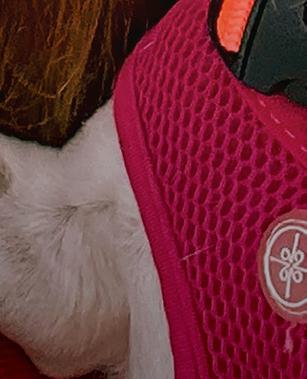












Sonya
Panashe Matemba-Mutasa


SATURDAY, SEPTEMBER 7, 2024

2700 Ninth Street, Berkeley | 10AM–4PM







The responsibility of ownership when pets become our extended family
When my partner and I started looking for our first home together, at the top of our musthave list was a yard for our 10-year-old Vizsla. Like most of his breed, “Mango” was athletic and sensitive—his favorite activities were running through Redwood Regional Park and curling up into a ball on the corner of our couch that got the most sunlight through the window.
Fortunately, we found a home near his favorite trails with a backyard, where he got his own couch in the sun. It made us happy to make him happy.
A few months later, we discovered
writes about climate, conservation and the Bay Area.
COOPER is a Bay Area-based journalist who covers science and culture while she studies at UC Berkeley Graduate School of Journalism.




that Mango had inoperable cancer. We engaged specialists, holistic modalities and essentially anything to make his life more comfortable and his transition as pain-free as possible.
After he passed, we were of course devastated. We built an altar and held a backyard memorial for him, inviting our friends and family to celebrate not just his life, but also the positive impact all our pets have on our lives.
Some of these benefits are on display in our story on seniors who adopt senior pets. Companionship, social connection and a sense of purpose await those folks willing to invest their time and devotion
to an elder canine or feline friend. In another story, we provide updated guidelines for neutering our pets, based on recent research and veterinary recommendations.
Our other stories in this issue aren’t directly related to pets. But I’d argue that they’re inspired by the joie de vivre that pets often provide. Just one of their many lessons to us. — Samantha Campos, Editor
Special thanks to Lisa Plachy for her editorial support. Lisa joins our team this summer as an intern from UC Berkeley’s Graduate School of Journalism. Her marketing experience and interest in magazine production greatly enhanced our process for this issue.
EDALATPOUR writes about arts, food and culture for SF Weekly, Metro Silicon Valley, East Bay Express and KQED Arts.
regularly contributes to the East Bay Express and other Bay Area publications.
a San Francisco-based writer who covers arts, community and culture in the Bay Area.
and




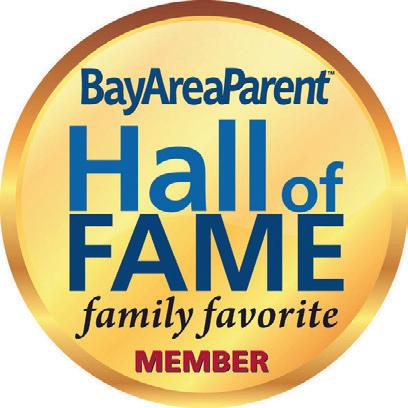



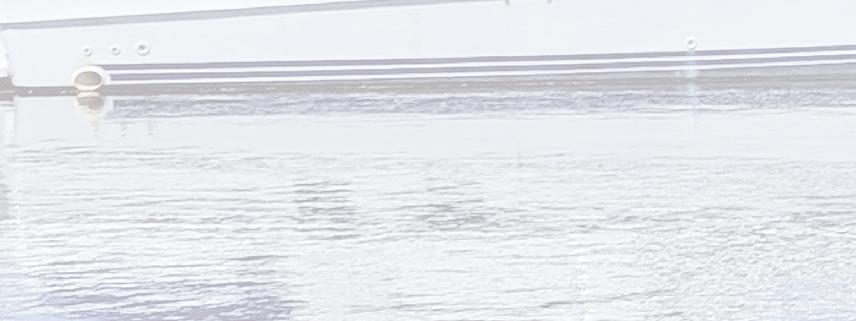

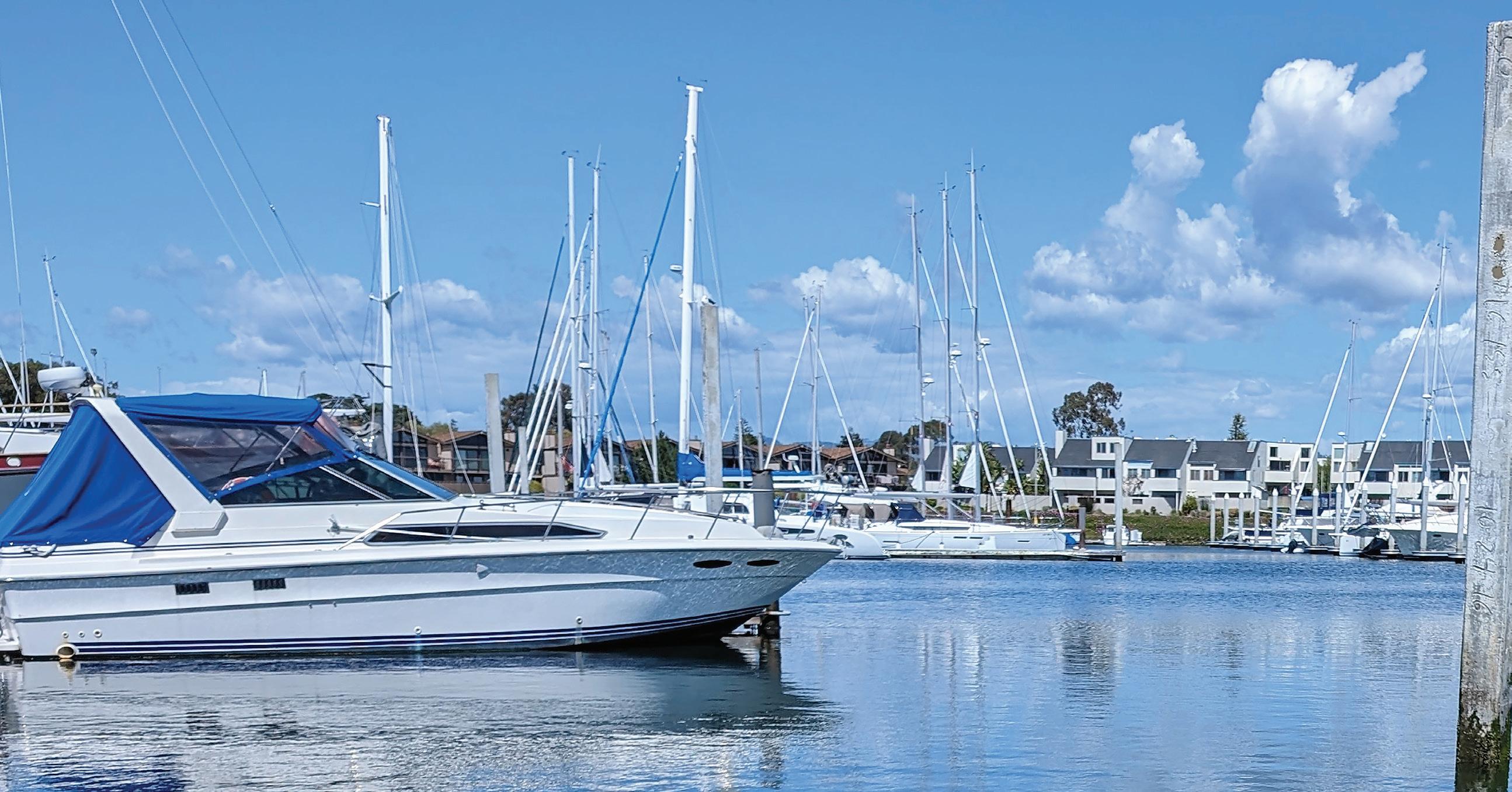






gives friends and families a unique way to connect to nature and each other.



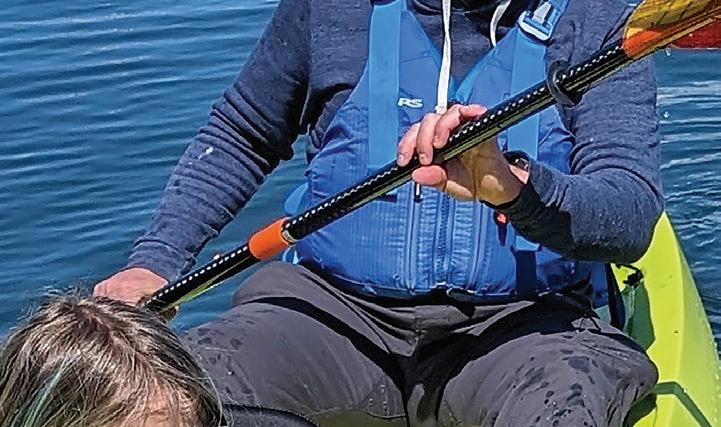









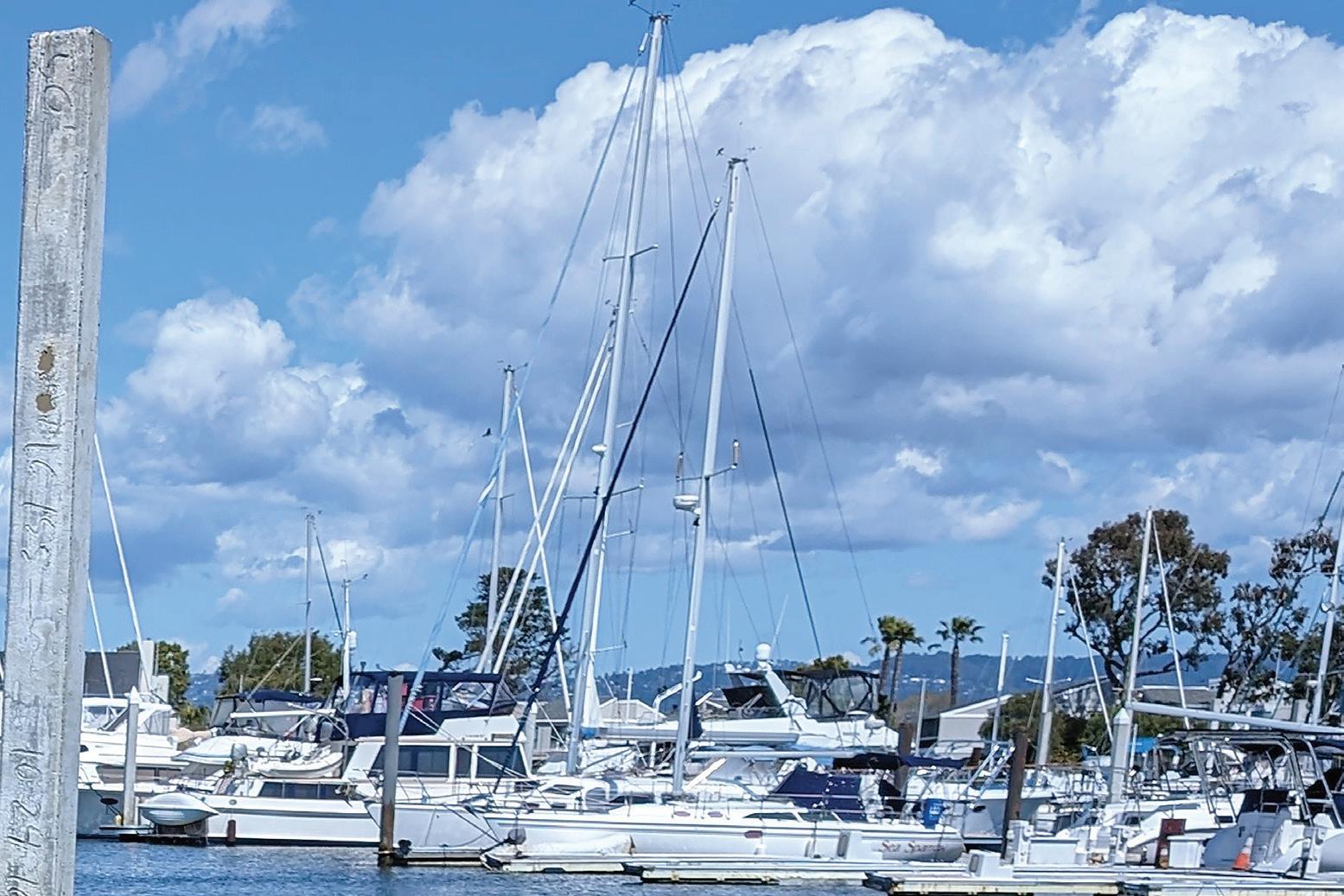
There’s something in the water in Alameda, and it might be a group of 50 8th graders in kayaks: Sea Trek just opened a second location at the Ballena Isle Marina after over three decades leading kayak and stand-up paddleboard trips and rentals out of Sausalito.










BY Sonya Bennett-Brandt






Alameda, our laid-back East Bay island, used to be a mere peninsula. In 1901, a little canal was scooped out along what is now the edge of Fruitvale, to make it easier for ships to bring goods to Oakland. Now, tucked along Alameda’s unassuming shoreline are some of the calmest, least-windy waters in the bay—which make it perfect for beginner kayakers and paddle boarders.
Sea Trek’s CEO, Galen Licht, grew up on the water. The company was founded by his father back in 1982. For him, paddling has a powerful potential to build a new kind of relationship with the natural world in our backyards.
“You’re all of a sudden at an arm’s reach, immersed,” says Licht. A paddler is up close with nature, in the thick of the marine ecosystem. “It’s a very unique and di erent perspective.”
To show this perspective firsthand, Licht guided me around a south-facing segment of the shoreline on a mini paddling trip—and as we paddled to Old Alameda Point, it was impossible not to appreciate our waterbird’s-eye view of the bay. It was a familiar vista from a very new angle; just beyond the neon yellow noses of our kayaks, giant container ships loomed on the horizon below the San Francisco skyline, gulls snatched fish a few yards away, and rocks exposed by low tide dripped with a seaweed crust.
It’s one of Sea Trek’s core beliefs that for someone to care about an area, they need to feel connected to it. “There are many ways that people can feel connected to their home, to their space, to nature,” says Licht. “We’re trying to o er one door: have water experiences.”
The opening of the Alameda location was partly motivated by a desire to get more kids out on the water “They get this great experience of being outside in nature, right in their backyard, outside their house,” says Licht. “The hope is that we’ll be able to provide water
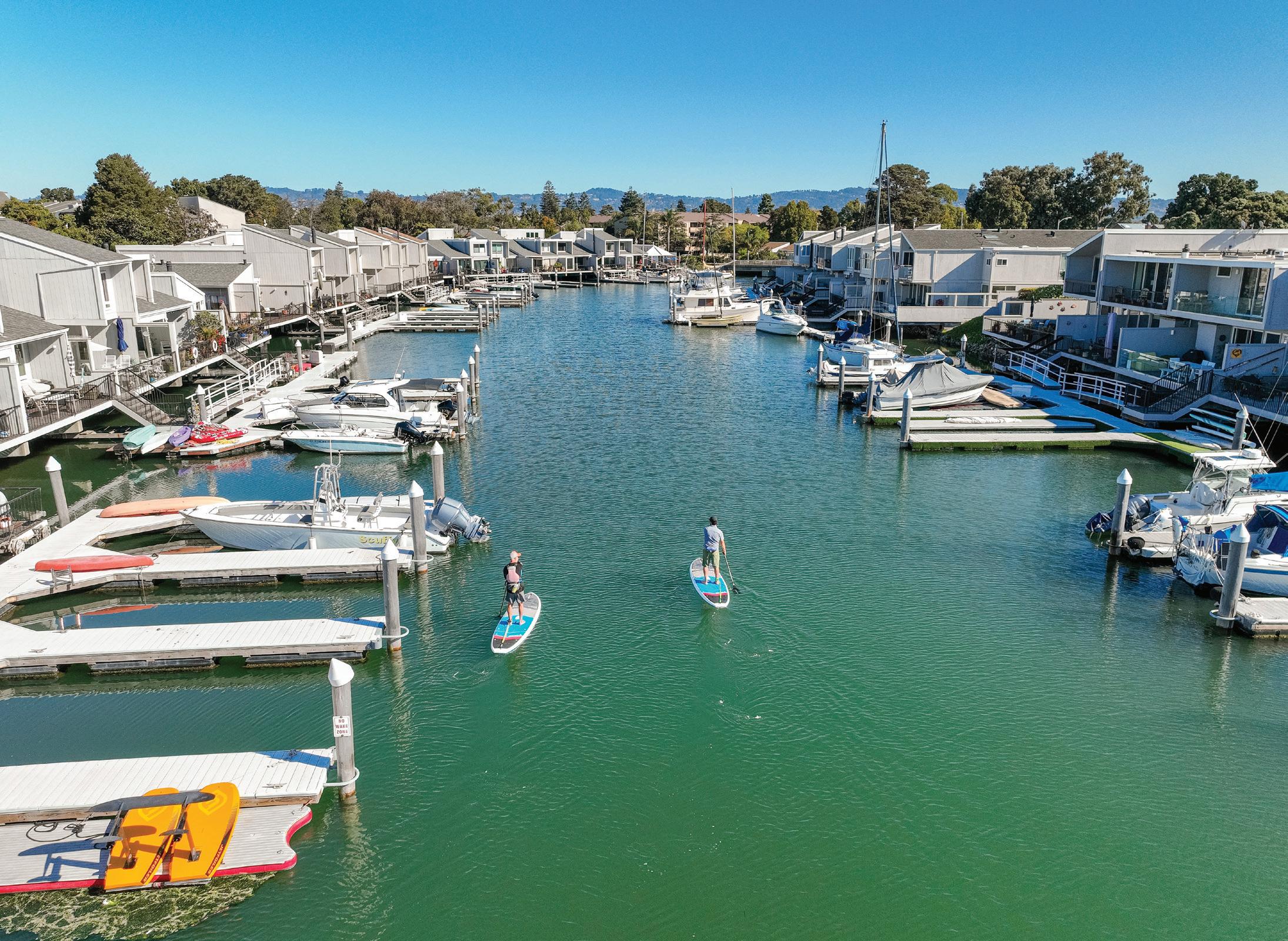
experiences to thousands of kids each year, because it’s so much more accessible for schools and people that live in the East Bay.”
In Alameda, they saw an opportunity to add value to the area amid an ongoing waterfront revitalization, and increase access to nature. They’ve started working with Oakland Goes Outdoors, which helps students in the Oakland Unified School District get outside—when I visited, they’d recently had groups of 50 and 80 students out on the water, broken into smaller pods of 12 explorers.
Sea Trek cares deeply about getting first-timers out on the water, and giving them that connection to the bay. “We’re a private, for-profit business, but we have a mission,” says Licht: “Provide enriching paddling experiences that foster deeper connections to nature, friends, family and self while cultivating environmental stewardship and caring for our communities in the San Francisco Bay Area and beyond.”
It’s a mouthful of a mission, but Sea Trek’s organizational attitudes bear it out—from their family-oriented vibe (many of their instructors and guides have been around for decades, and their kids are now instructors and guides) to their pricing (a membership comes with free rentals for kids under 15 in same family) to their focus on making water experiences more accessible.
“Outdoor recreation is predominantly a white space,” Licht says. “I find it important for us as a business to recognize that, and be proactive.”
In Alameda, they’re partnering with Emily Taylor, who creates outdoor adventure programs for BIPOC, LGBTQ and neurodiverse youth in the Bay Area “Our main focus is getting BIPOC and LGBTQ underrepresented folks into the nature environment,” says Taylor. “But we also have to bridge that in a way that’s healthy for us and our bodies.”
Sometimes that means having conversations with outfitters “about what
it means for us to have sovereign joy,” says Taylor. “And looking at us like adventurers and treating us like adventurers, and not like newbies.”
Taylor has been bringing groups to Sea Trek regularly, and the kids are adventure pros. “What’s beautiful is that I have six and seven year olds who all come out and know how to pull their own boats, grab their own gear, put their stuff in the slip and take off on their own,” says Taylor. “Sea Trek has actually become more of a family. They’ve become a bigger part of the bridge that we’ve been looking for.”
Sea Trek recently hosted a Summer Solstice party with music, food and discounted rentals; 20% of proceeds went to Taylor’s organization, Brown Girls Climbing, through their “Sea Trek CARES” program, which donates some of their profits to local groups that promote community involvement and collaboration for bay conservation and stewardship.
For Sea Trek, community involvement also looks like forging connections »


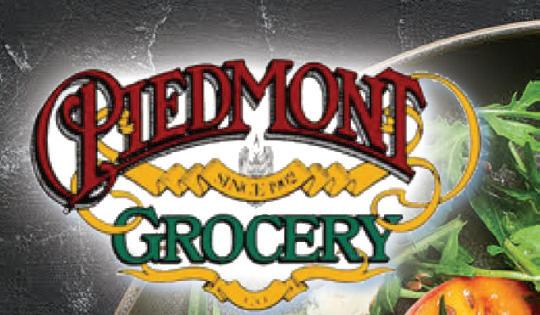







with local businesses. They surveyed paddlers at their Sausalito location and found that 60% of their customers pair their trip out on the water with a meal or coffee in the area. Licht anticipates that the same thing will play out in Alameda, as people take advantage of the growing number of restaurants, cafes and breweries next door and contribute to the ongoing revitalization of the Alameda waterfront.
Another big part of pushing accessibility is making paddling logistically easy for beginners. “We thought through all the barriers and tried to remove as many as possible,” says Licht. The price of the kayak or paddleboard rental includes all the additional gear you might need: life
jacket, dry bag, pants, windbreaker. All customers need to do is bring themselves (ideally wearing some sunscreen and sunglasses—it gets bright out there).
Once one is kitted up and snug in a boat, there are a variety of options for different skill levels and interests. World War II buffs can paddle north to the USS Hornet at the former Naval Air Station; wildlife lovers can look for roosting pelicans on Breakwater Island or harbor seals lounging on a floating dock. Those looking for a leisurely outing can have a relaxed paddle around the tranquility of the marina; more ambitious seafarers can circumnavigate the entirety of the island. There’s something for any skill and ambition level.
“Some people come back soaked; some people come back totally dry,” says Licht. But everyone is usually pretty hyped about their day out on the bay. “People come back with smiles on their faces.”
The sightseeing from an Alameda kayak is charming and eclectic: sleek boats docked in the marina with intriguing names like Lil’ Bear and No Witnesses, a great blue heron flapping overhead, families scattered across Encinal Beach. Paddlers regularly see pods of dolphins skipping by, or get peeped at by roundheaded seals. It’s a uniquely East Bay blend, and Licht thinks that more people should get to see it.
Says Licht, “People come on the water and are like, “Wow—this is my home.” ❤














BY Je rey Edalatpour
Rose Clarke has been dreaming of owning a restaurant since she was young. “I loved eating with my parents,” she recalled. “They would throw parties, and we’d also go out to dinner.”
Before opening Roses on Adeline with her parents, Clarke was working in San Francisco for the Flour + Water Hospitality Group. “Initially, I worked the sandwich line as a prep cook and then later on as a line cook for Penny Roma when it first opened,” she said. Clarke also worked for a year as a line cook at Good Good Culture Club in the Mission.
When Nick’s Lounge was up for sale in

late 2020, about three blocks away from Clarke’s house, her parents purchased the bar. “It had always been something my parents and I talked about,” Clarke said. “What if my dream became their dream because they’re both architects, and they do a lot of restoring and renovating.” After the sale went through, it took a solid three years to fully renovate it. Clarke and her family transformed an ultra-casual dive bar into an art-deco-inspired jewel box.
“My dad is extremely artistic, and he’s got a great eye,” Clarke said. “Based on my experience in commercial kitchens, I had a lot to do with the kitchen design. And then later I was involved in the decoration, the colors of the walls and booths and bathrooms.”
There isn’t a single interior detail that’s been overlooked. The tiles behind the bar form a pattern made from the colors of a harlequin’s jumpsuit— periwinkle, amber and verdigris. From the ceiling beams to the floor boards, red
and blonde woods exude warmth and coziness. It’s the kind of wine bar that’s made for intimate conversation, date nights and lingering in general.
“Ever since I started working at restaurants, I always had this idea in my mind that eventually I would have my own spot,” Clarke explained. “I was constantly looking at it from that lens of, ‘What do I like, and what do I want to bring to my place?’” Compared to being a line cook, becoming an operations manager is the hardest thing she’s ever done. “Stress and anxiety-wise, there’s a lot at stake,” she said. “The pressure that I have to make money is hard, but it’s definitely worth it.”
Clarke created a small menu featuring bar bites, shared plates and desserts. “Basically it’s bar food that’s slightly elevated,” she said. “It’s comforts and classics with a little twist driven by seasonal products.” Among the bar bite choices, there’s a charcuterie plate ($19)
and a double smashburger ($19). More substantial fare includes lamb and beef kefta meatballs ($23) and katsu-style fried chicken ($21).
“It makes the job a lot more fun when you’re able to switch it up,” Clarke said. “Certain things will always stay, like the burger, but I want to add to the menu once I feel that I can be 100% behind the items I do bring on.” During the soft opening phase, the menu was much bigger. “We pared back because it was just too much to start with,” she explained. And they wanted to highlight the wine list and curated cocktails concocted by bar manager Jennifer Colliau.
“We were super lucky to have Jennifer apply,” Clarke said. “She’s a long-time Berkeley resident, and she was super down with our vision.” When Clarke and Colliau met to discuss the cocktail menu, Clarke told her that she loved candy and edible garnishes. “Our drinks have stu like that because she also has a big
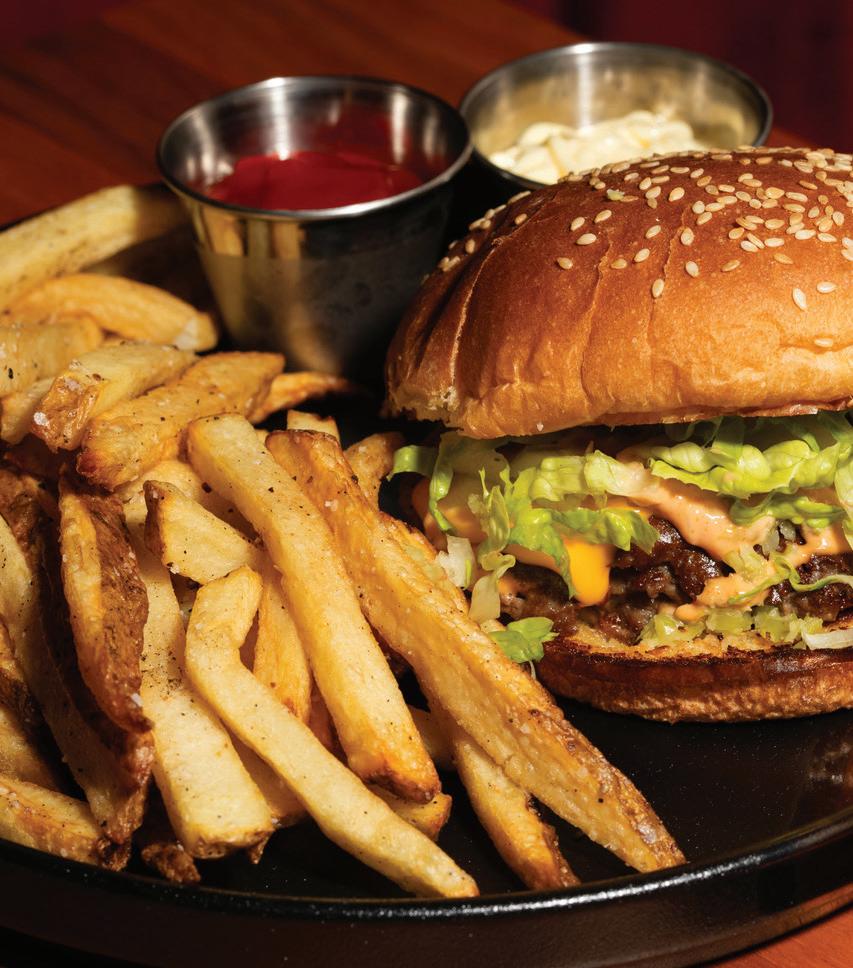
‘We feel that the area has so much potential. We just wish there were more businesses like ours. We hope that we can inspire more to come so we can have better foot traffic.’

sweet tooth,” she noted. Colliau, a wellregarded bar consultant and mixologist, used to run her own bar, Here’s How in Oakland, which closed in 2020 at the start of the pandemic.
With only eight wines to choose from now, the wine list was deliberately cut shorter. The longer list of options distracted attention away from the cocktails. “It was hard for us to choose only a few because we tried so many that we liked and really wanted on the menu,” Clarke recalled. Currently, there are wines from France, New Zealand, Italy and Santa Barbara, with jaunty descriptions like “Zippy White” for a glass of sauvignon blanc ($11) and “Skin Contact” for a carbonic orange ($15).
During the day, the South Berkeley neighborhood is busy with people working in the area and the Tuesday farmers’ market. But, Clarke said, at night it’s much quieter. “We feel that the area has so much potential. We just wish there were more businesses like ours,” she noted. “We hope that we can inspire more to come so we can have better foot traffic.”
Neighbors have already told Clarke they’re glad Roses on Adeline moved in. She added, “In this area of Berkeley, people are really excited to have an all-around neighborhood spot that has cocktails and food that’s a little bit special.”
Roses on Adeline, open Thu to Mon 4pm–late, 3218 Adeline St., Berkeley. 510.903.6733. rosesonadeline.com.

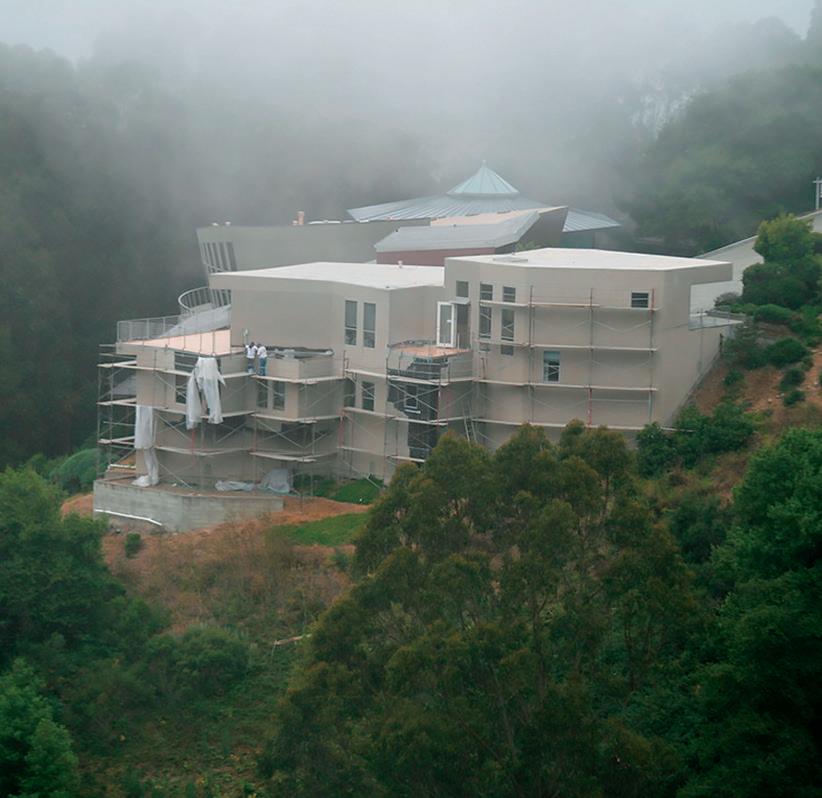

“You’re the only contractor I liked better after the job was
• We rebuild all types of windows, and change out glass
• Deck, bridge driveway waterproofing
• Below grade foundation repair and waterproofing
• We love tile roofs
• Structural and dry rot repairs
• Waterproofing & Coatings
So-called modern clad windows start falling apart after 10 years. Restoration will save your investment. See the story on our website: www.kardelcompany.com
Clients receive an original David Lance Goines Poster
SEASON OPENER
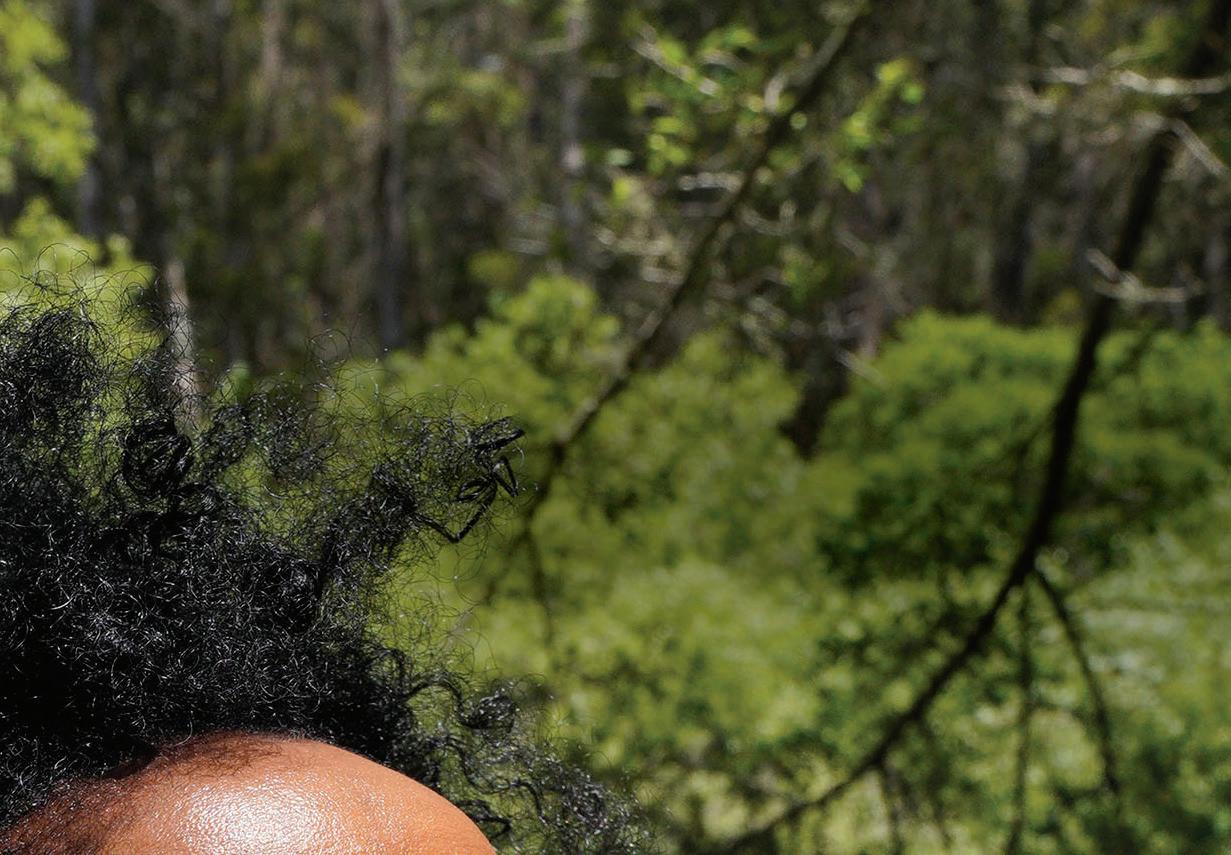

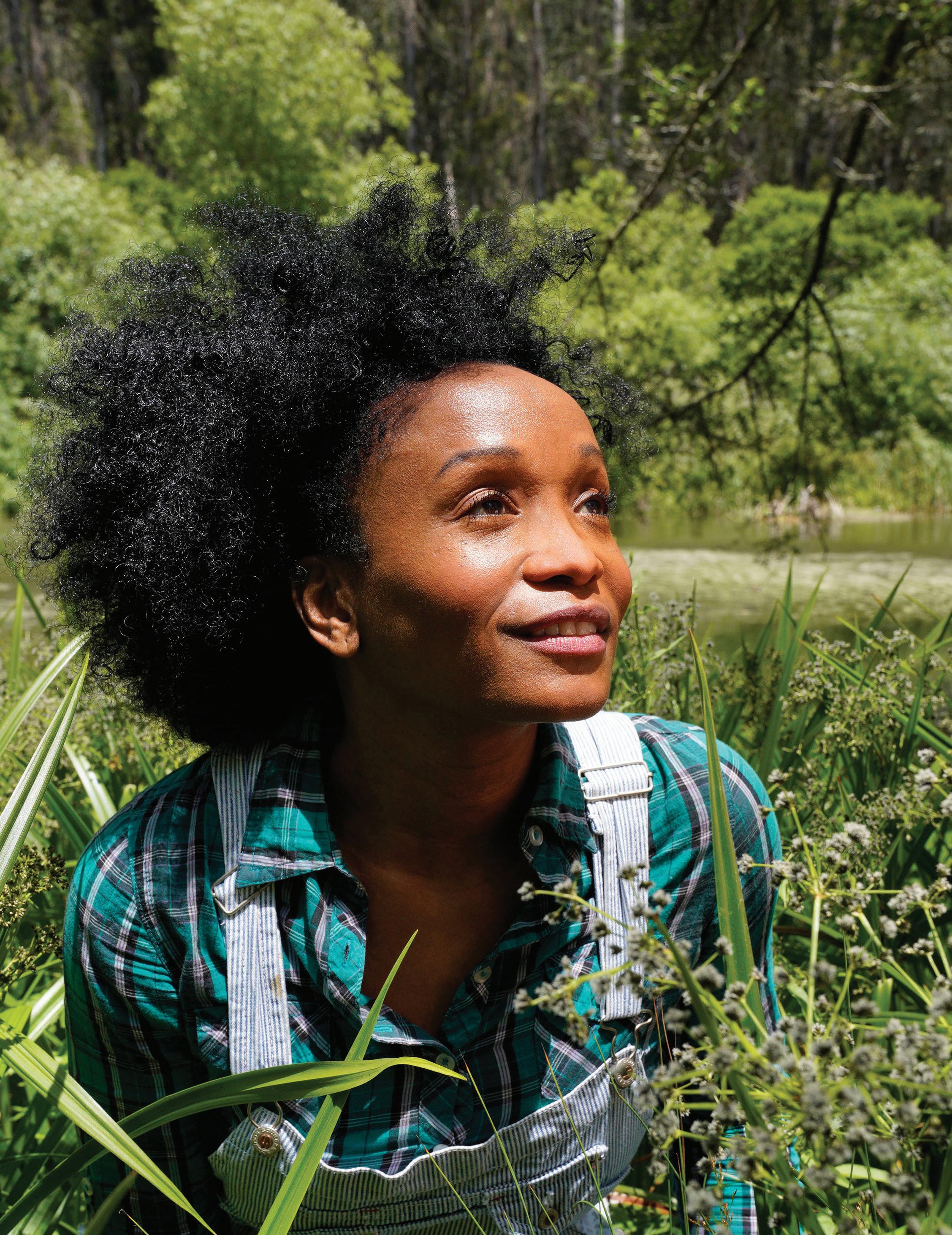





BY Janis Hashe
Cellist Jacqueline du Pré died at 42 of complications from multiple sclerosis.
But during her brief, brilliant life, she was “a supernova,” said Marnie Breckenridge, the soprano who will portray her in West Edge Opera’s production of Jacqueline, Aug. 10, 16 and 18.
Breckenridge has been involved in the opera since its inception. She had worked with composer Luna Pearl Woolf on a previous project, and was friends with librettist Royce Vavrek. When the idea arose to base a piece on du Pré’s story, centered around the structure of Elgar’s “Cello Concerto,” of which du Pré’s interpretation is considered a classic, she was eager to participate. Jacqueline premiered in 2020 at Toronto’s Tapestry Opera.
Starting with a series of workshops,
which included cellist Matt Haimovitz, who had known and taken master classes with du Pré, the two-character result uses the concerto’s four-movement structure to illuminate the musician’s triumphs and tragedy. Haimovitz’s character is literally du Pré’s cello.
“The cello is her inner psyche and her lover,” said Breckenridge. Although the singer did a great deal of research on how MS a ects the body, and this is portrayed in the opera, her performance is “not a caricature. But [Jacqueline] is talking about how it a ects her.”
Breckenridge was moved by a quote from du Pré in which she describes “thumping and bumping down the stairs,” and she is known to have commented that eventually, she had problems judging the weight of the bow on the cello’s strings as her fingertips
became increasingly desensitized.
Yet she continued to perform for as long as she could. “She was the queen of glissando,” said Breckenridge, referring to the rapid glide from one pitch to another.
Du Pré was also a gifted singer, she said, citing videos of her interpreting classical compositions. She was a powerful woman, who “straddled her Stradivarius when women were still playing sidesaddle,” according to Breckenridge.
Matt Haimovitz has been familiar with du Pré, her music and her story since he was a young boy beginning cello lessons. “I began listening to [her] LP, her first recording of the Elgar Cello Concerto. I wore out the vinyl,” he said.
He and Woolf had been discussing collaborating on an opera, “a world outside of my usual sphere of instrumental music with no words,” he said. “She
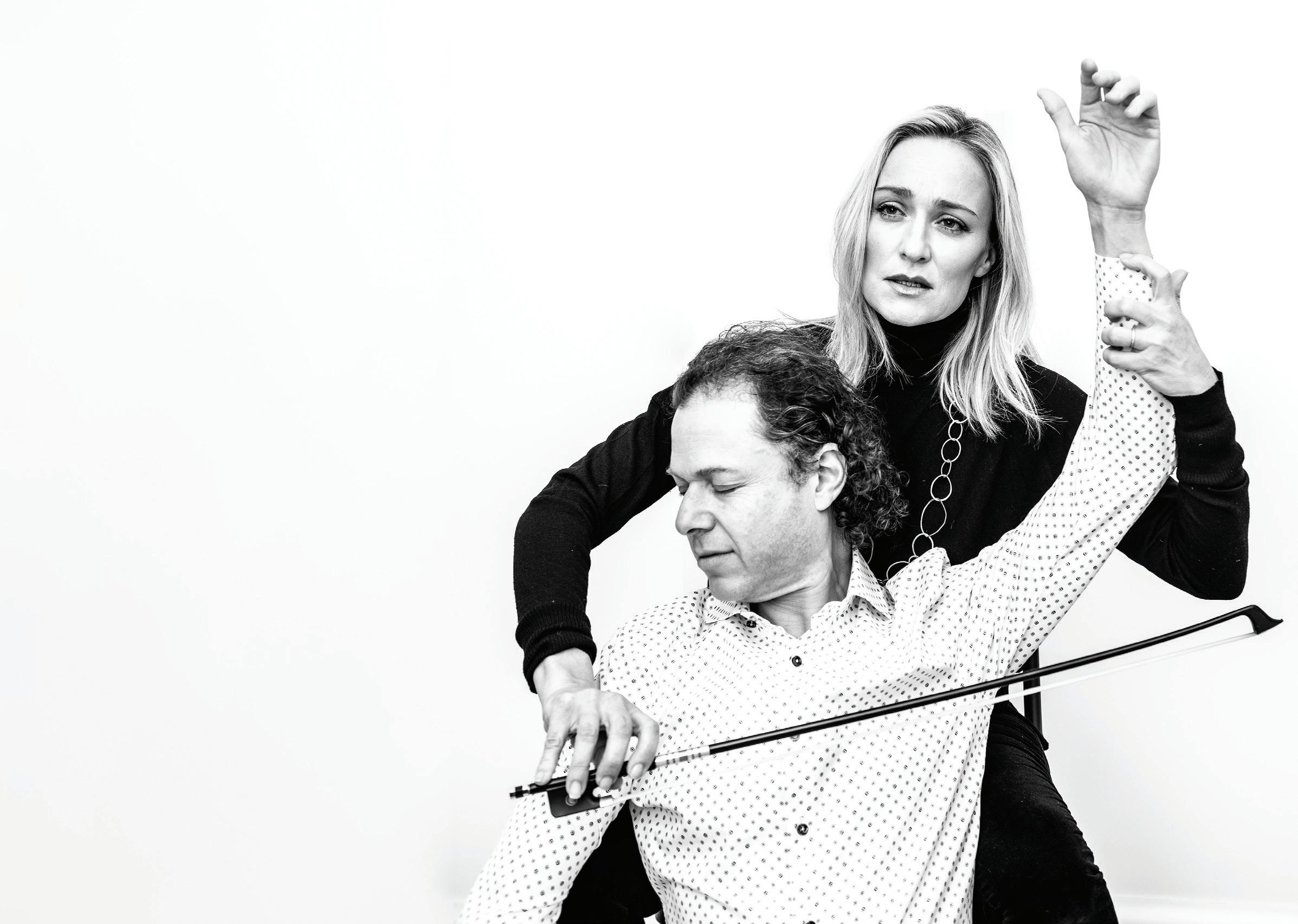
knew about my close relationship with Jackie and instinctively felt that her story, inspirational and ultimately tragic, was a natural for the operatic stage.” He and Woolf consulted du Pré’s close friend, Toby Perlman, as well as her husband, Daniel Barenboim.
Haimovitz enjoys collaborations with Breckenridge. “Not only does she have a gorgeous voice and a big heart,” he said. “She listens and responds like an instrumentalist. It is rare to find that level of trust on stage and in rehearsal. Both of us are always seeking to delve more and more deeply into the work.”
Jacqueline, said Breckenridge, of course has tragic elements: the foreshortened life of someone so talented and inspirational. But it’s a “bittersweet triumphant story…her work stands up to today’s artists. She continues to live through it.”
Haimovitz writes in his liner notes for the recording of the piece: “This opera
is personal on many levels. I am beyond grateful to be able to enter the world of Jacqueline, the opera, to keep the memory of this force of nature alive, but also to reflect on my own journey. As with my time listening to music with Jackie in her London apartment, the immersion into her story o ers a moment of peace.”
WEO general director Mark Streshinsky explained how the opera became part of this summer’s o erings.
“I flew to Toronto in 2020, just before the pandemic, specifically to see Jacqueline,” he said. “The performance thrilled me…my hopes were far exceeded. I immediately knew I wanted to bring this piece to West Edge.”
Jacqueline is the final WEO presentation of the 2024 season’s rotation. But the two operas taking stage before it, and a special presentation that follows it, all feature women, some real, some fictional, who are truly entitled to be called supernovas.
Season opener Bulrusher, based on Eisa
Davis’ play, tells the story of a young girl who is found in a basket by a river in Northern California’s Anderson Valley, raised by a local schoolteacher—and has never seen anyone who looks like her until a Black woman from Alabama comes to town. (Aug. 3, 11 and 15)
There is perhaps no more iconic opera character than Wagner’s Brunnhilde, and she’s back in the second season o ering, Legend of the Ring, which combines elements of all four epic operas into one “actionpacked evening of divine music…back by popular demand,” WEO materials state. Can’t put out that fire! (Aug. 4, 9 and 17)
Finally, Dolores is the second completelength opera to be commissioned and developed by West Edge Opera. (Bulrusher was the first.) Dolores was initially commissioned in 2021, and has been in development since then. A complete piano vocal workshop, which is not open to the general public, will be presented at the Scottish Rite Center in late August.
»

















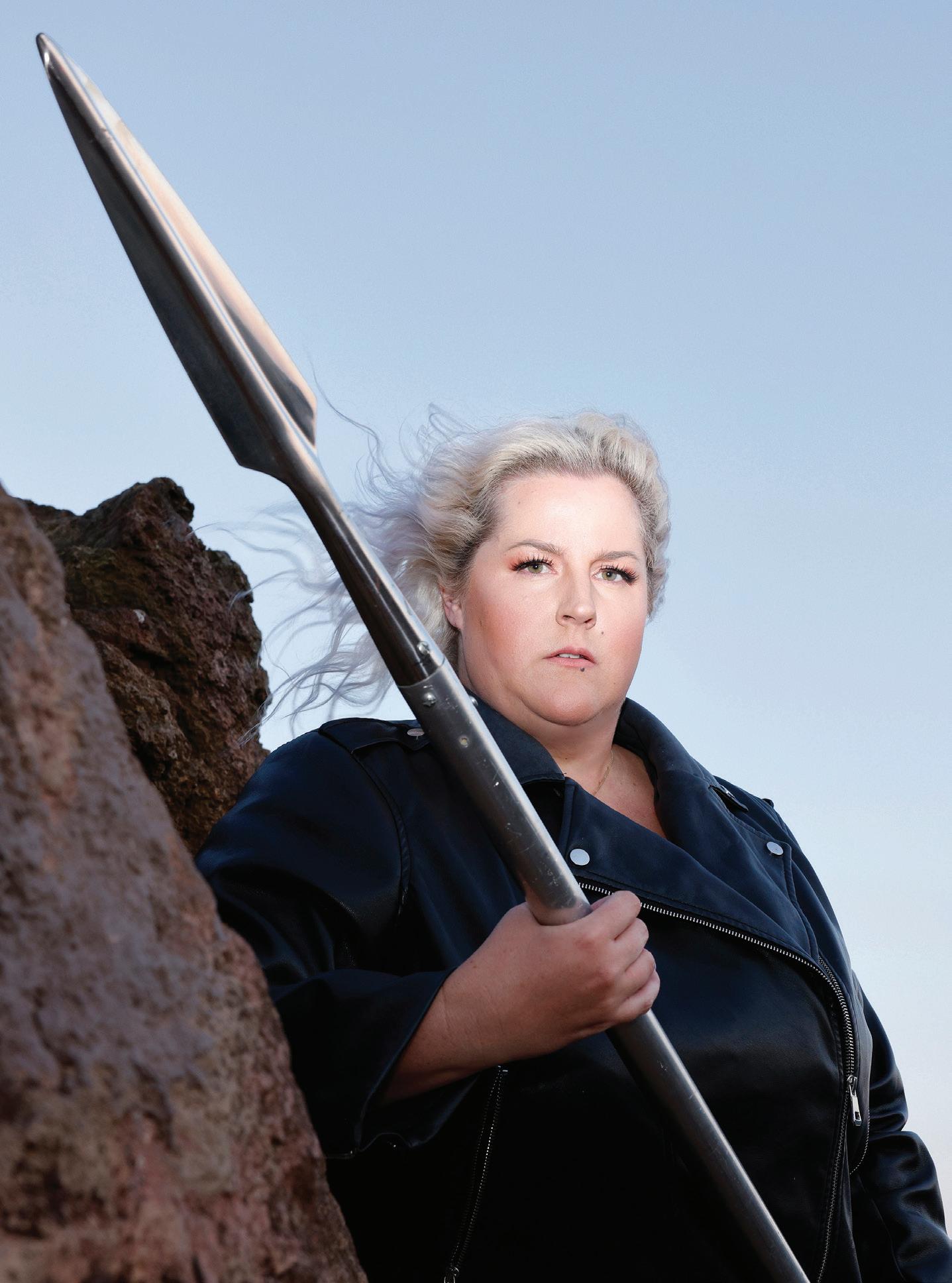













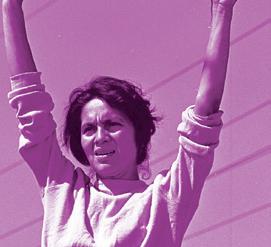







«
The opera is scheduled for a full staging in the 2025 season.
Dolores illuminates a few weeks in the life of civil-rights legend Dolores Huerta, as she celebrates the candidacy of her friend and supporter, Sen. Robert F. Kennedy, and then mourns— and survives—the catastrophe of his assassination.
Said Streshinsky, “Dolores continues to evolve with the inclusion of director Octavio Cardenas, scenic designer Liliana Duque Piñeros and costume designer Ulises Alcala.” After the piano
vocal workshop, “[composer Nicolas Lell Benavides] will have about nine months for anything that needs to be changed from the workshop and to finish the orchestrations, all in anticipation of the premiere in summer 2025.”
As is the WEO tradition, the season o ers something for everyone, Streshinsky agreed. “We always think about varying interests and tastes when we program a season. My greatest wish is that someone who loves an opera like The Ring will dip their toes into a new opera like Bulrusher and discover they love it!” he said.
For the third year, WEO is back at the Oakland Scottish Rite Center, which continues to be upgraded for safety and comfort. WEO traditions that continue are Streshinsky’s pre-performance “Opera Talks,” and the ever-popular free wine pre-show and at intermission. Opera-goer’s tip: Take advantage of the proximity of the Lake Chalet Seafood Bar & Grill for a pre-supernova meal.
West Edge Opera Season 2025, Aug. 3-18, Oakland Scottish Rite Center, 1547 Lakeside Dr., Oakland. 510.841.1903, www.westedgeopera.org.











Linda Wroth says her dog, Nami, is naturally very well-behaved.




BY Lisa Plachy




























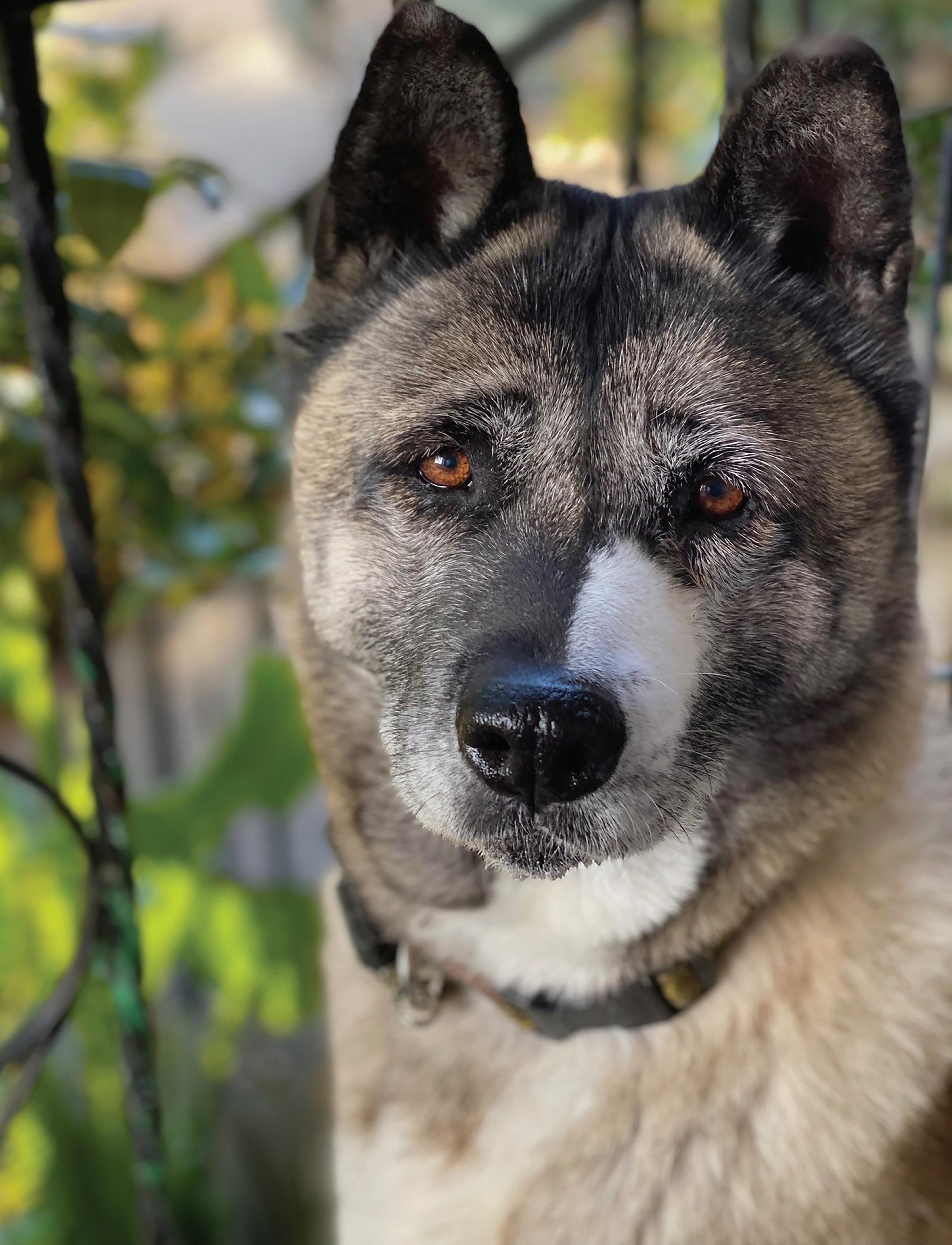



When Sally Brook and Luna go for walks in her West Berkeley neighborhood, Brook likes to describe, out loud, what’s going on around them.
“This house has a very big dog that’s going to bark when we go past,” she tells Luna. “But don’t be afraid.”
Luna is an 11-year-old terrier mix who’s nearly blind. That’s not a problem for Brook. When the 79-year-old was looking to adopt a dog, she only had a few requirements. She didn’t want a younger dog—“They’re too energetic, and I’m not that energetic anymore,” notes Brook. But she did want one who could go on walks with her. “It’s not fun to walk by myself,” she says. “If you have a dog, people stop and talk to you. It also gives you someone to talk to.”
According to the American Pet Products Association, boomers over the age of 65 account for 24% of current U.S. pet owners. A recent report from the organization found that a large majority—80%—cite happiness and emotional support as specific benefits of having a pet. To help facilitate this, several programs across the Bay Area exist to pair harder-to-adopt animals with the people well suited to care for them, like Brook cares for Luna.
About 15 years ago, Berkeley Humane began its Golden Paws program, o ering senior adopters a 50% reduced adoption fee on cats and dogs older than seven years.
“It really came out of the idea that an ideal home for some of our senior animals is a quieter home,” said Je rey Zerwekh, executive director at Berkeley Humane. At the East Bay SPCA, which has shelters in Oakland and Dublin, and Muttville, a dedicated senior dog rescue in San Francisco, “Senior for Seniors” programs waive adoption fees entirely.
“I think everyone knows how beneficial pets can be for senior citizens—and senior pets in the shelter are often some of the most challenging to get adopted,” says Karalyn Aronow, vice president of
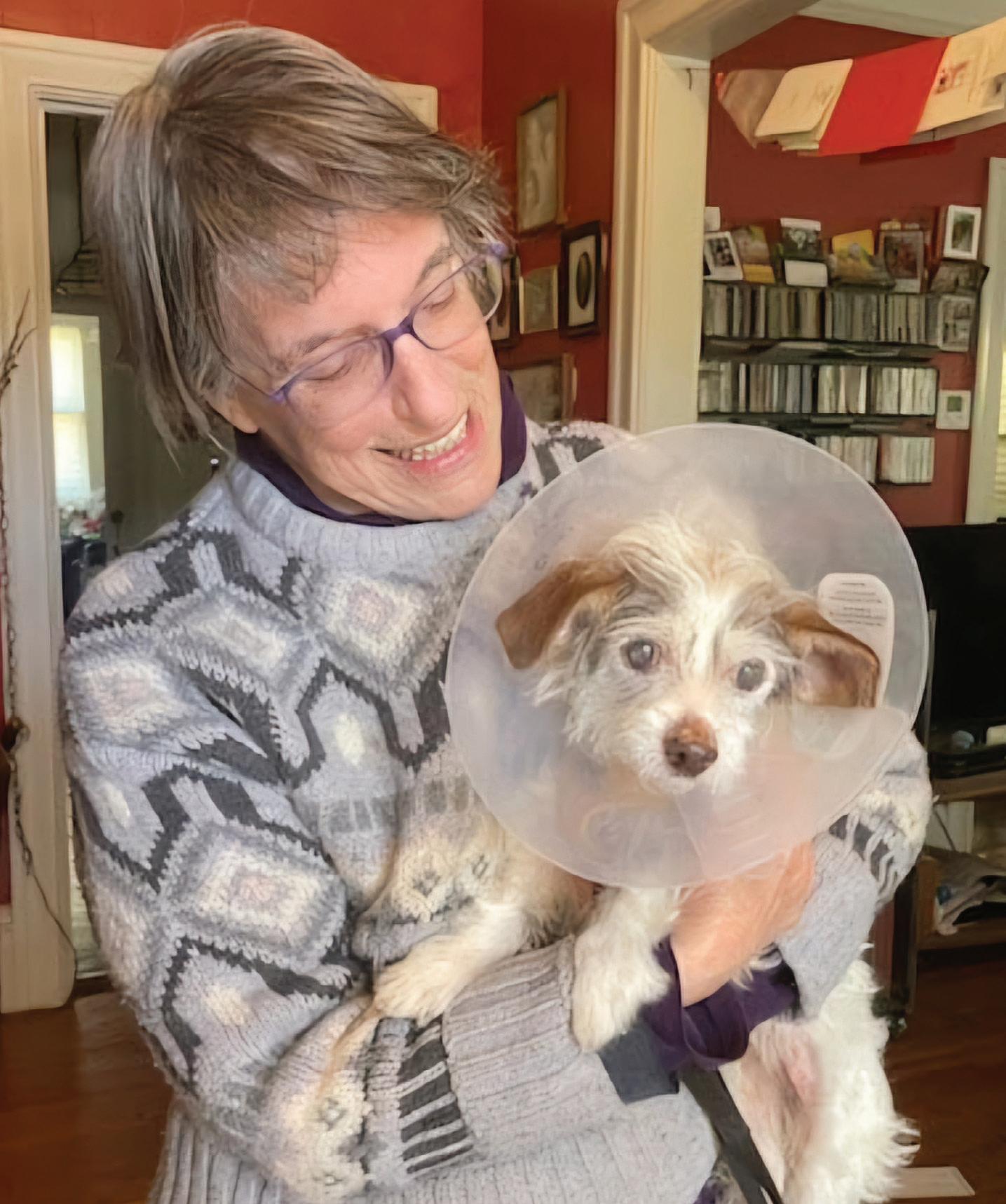
operations at East Bay SPCA. “So we were like, well, let’s make this a win-win.”
At East Bay SPCA and Berkeley Humane, these programs connect anywhere from 12 to 15 senior pets and people a year. And at Muttville, 44% of adopters are seniors—they rescued over 500 dogs last year.
Janice Lenderman, a 67-year-old resident of Castro Valley and a volunteer at the SPCA’s Dublin shelter, saw firsthand the challenges of older pets competing for attention with younger ones. Three months after coming to the shelter, 10-year-old Missy and nine-yearold Buddy, a bonded cat pair, weren’t getting adopted. In late May, Lenderman decided to take them home herself.
“I did my best to get somebody else to adopt them,” she says. “They kept saying no, no, we’re going home with you.”
This unpredictability is common. While the idea of matching senior pets with senior people carries certain assumptions about both the humans and pets involved, shelters say it’s all about finding the right fit rather than focusing exclusively on a pet’s age, breed or even size.
“I have seniors that are 73, 74 years old that don't want to couch-potato dogs. They want a dog that takes them for a walk,” says Sherri Franklin, the founder of Muttville. “We really try and match-make energy levels and care levels.”
This concept of matchmaking even
extends across species. Claudia Hunka, the owner of Your Basic Bird in Berkeley, says that lifestyle is always a consideration for recommending birds. “That doesn’t matter whether you’re 15 years old or you’re 45 years old,” she adds.
The matches, however, aren’t always expected.
For 17 years, Jan Ruchlis had the reliable companionship of Milo, a 95-pound Great Dane Labrador Retriever mix that accompanied her on hikes in the Berkeley Hills area. After his death, it took her a long time before she was ready for a dog again. Then, during the pandemic, she couldn’t find the right one.
“I had been checking on many websites after that two years, and it was going nowhere,” she says. Then her daughter, a foster parent for Muttville at the time, gave her a call. “She said, Mom, I think I’ve got a dog for you.”
Enter: Heidi, a charming, affable terrier mix who clocked in at all of 15 pounds. After a particularly scary incident with a coyote, Heidi can’t quite fulfill the role of formidable hiking partner. But she’s still brought so much to Ruchlis’ life.
“Heidi has just been a godsend,” Ruchlis says. “She got me through the pandemic, and she got me through a divorce. We just hang out together a lot.”
Others have found ways to keep their favorite dogs in their lives—like Linda Wroth, an 83-year-old resident of East Richmond Heights, who spent three decades taking care of Akitas.
“They [Akitas] just were a good fit for me,” she says. “As I became older, I became less active, and they’re not active in general. They’re just happy to have a good place to sleep.”
Two years ago, Wroth began fostering Nami, an Akita that, at 64 pounds, was a little smaller than her previous ones. Between Nami’s spinal problems and Wroth’s achy knees and hips, she says they’re well suited for each other. Choosing to foster also gave Wroth a sense of security; she says the “transition would be smooth” if she were to pass before Nami.

Wroth feels blessed to be able to care for Nami’s medical issues, and takes a special interest in doing so. She brings Nami to regular vet, chiropractor and grooming visits. The trade-offs she’s had to make are worth it, Wroth says, to see her happier and healthier than when she came in.
Within days of Luna’s adoption, Luna and Brook were completely enamored with each other. As she learned to navigate her new home, Luna began following Brook around like a shadow. It might be why Brook is unfazed by some of the extra medical attention that senior dogs like Luna sometimes require.
“They are so happy to get adopted,” she says. “They may be a little more work, but it’s worth it.” Plus it’s nice, Brook says, to
have a dog around the house.
For Lenderman, it was a matter of familiarity. Before Buddy and Missy, she found herself without cats for the first time in over 40 years.
“These two ended up being the ones who filled out the job application,” she says. Now, “It’s kind of nice to have two other souls around. Hopefully they feel the same.” ❤

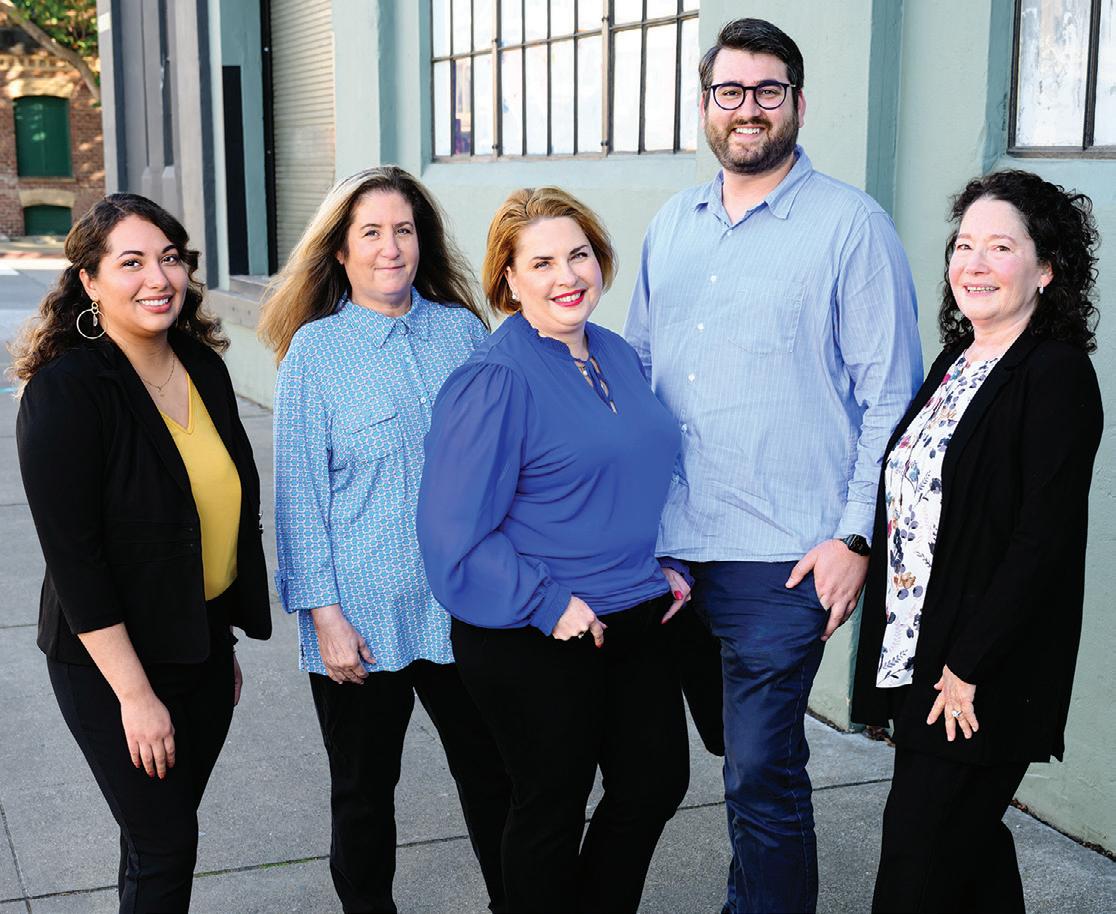






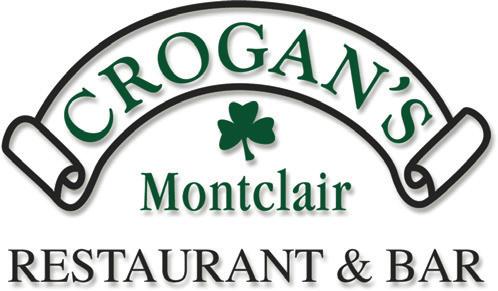






Research challenges old assumptions of spaying and neutering timelines
BY Jordan Cooper

East Bay animal shelters are in for quite the rewiring if county dog fixing standards catch up to the new vet-recommended age guidelines for neutering. But it may also relieve some of the pressure on owners struggling to get a neuter appointment. Following the new age of neutering guidelines may also save a dog from serious future medical conditions.
In the pandemic, the U.S. saw a surge in pet adoptions—loving companions were all the rage when no one left their homes. A Forbes Advisor survey found that 78% of pet owners acquired a pet during
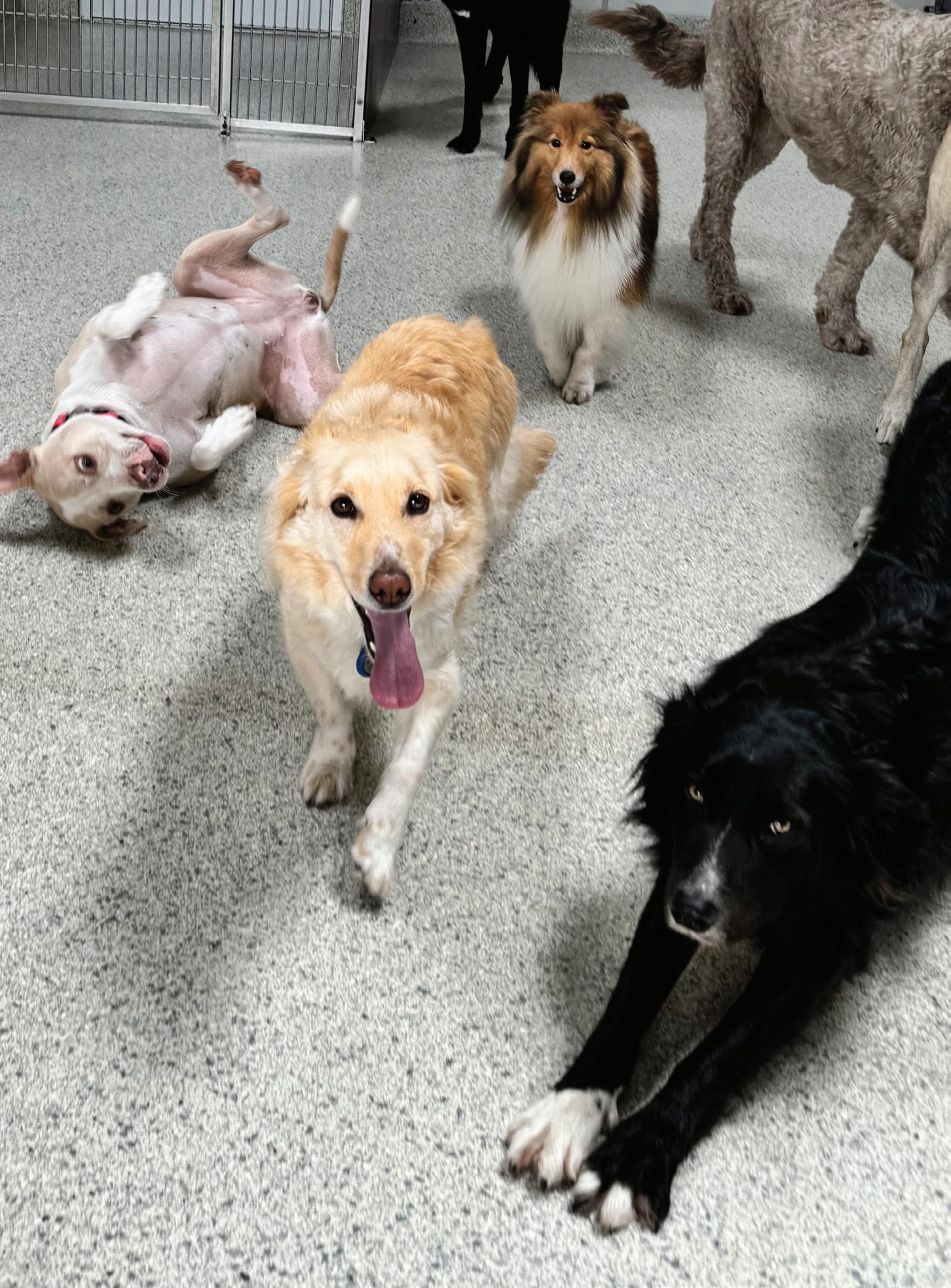
«
the pandemic. Now, post-pandemic, shelters are overpacked with pandemic dogs whose owners could no longer accommodate having a dog and a normal work schedule. Just as worrisome is the disproportionately higher number of pets than vets, making it harder for owners to schedule veterinary appointments even for the most practical of procedures.
According to Mars Veterinary Health, the country has a veterinarian shortage and would need more than 30 years' worth of veterinary school graduates to fill that 10-year industry need for licensed veterinarians. At multiple East Bay clinics,
there is up to a six-week wait for a spay or neuter appointment, leaving many owners with unfixed, quickly maturing adult dogs.
The general rule for neutering is to leave cats intact until they’re four months old and dogs until they’re six to nine months old. That three-month range for neutering dogs is based on the rates at which different dog breeds mature. Though they often live shorter lives, larger breeds, like Great Danes and Golden Retrievers, generally mature later than their smaller relatives and weigh more—often with more muscle, making them heavier on their joints and increasing their risk of
joint disorders. Veterinary professionals now say that the three-month range may not be large enough.
When the first of the more than a dozen studies began in 2013, Lynette A. Hart (PhD from Rutgers University) and her co-authors didn’t know the breed they were starting with would become a perfect example of the complexities of neutering timing.
“We started with the Golden Retriever, which just by accident was the one that’s kind of the worst-affected [by neutering],” said Hart. “Such a compatible breed working in service work—but they have so many cancers that Bonnie Bergin, the inventor of the breed, said she isn’t going to [breed] them anymore.”
The 2013 paper, “Neutering Dogs: Effects on Joint Disorders and Cancers in Golden Retrievers,” explains the process of analyzing the medical records of 759 intact and fixed Golden Retriever patients and finding the effects of neutering age. The females took the brunt of the risks of neutering and are advised to stay intact—i.e., forgo the surgery.
Neutering early (before six months) increases the risk of tearing the knee ligament (CCL), and neutering late increases the risk of a fast-growing blood vessel cancer (HSA) and a cancerous tumor (MCT). Males are recommended for neutering after 12 months.
The records of 39 other dog breeds and three different weight classes of mixed breeds have been similarly analyzed over the last 11 years and, apart from female Golden Retrievers, male Doberman Pinschers are also recommended to be left intact.
The males of six breeds are recommended to be fixed only after two years of age: Bernese Mountain Dogs, Boxers, German Shepherds, Irish Wolfhounds, Mastiffs and Standard Poodles. For the other sex, six ALL INCLUSIVE Happy Hound welcomes


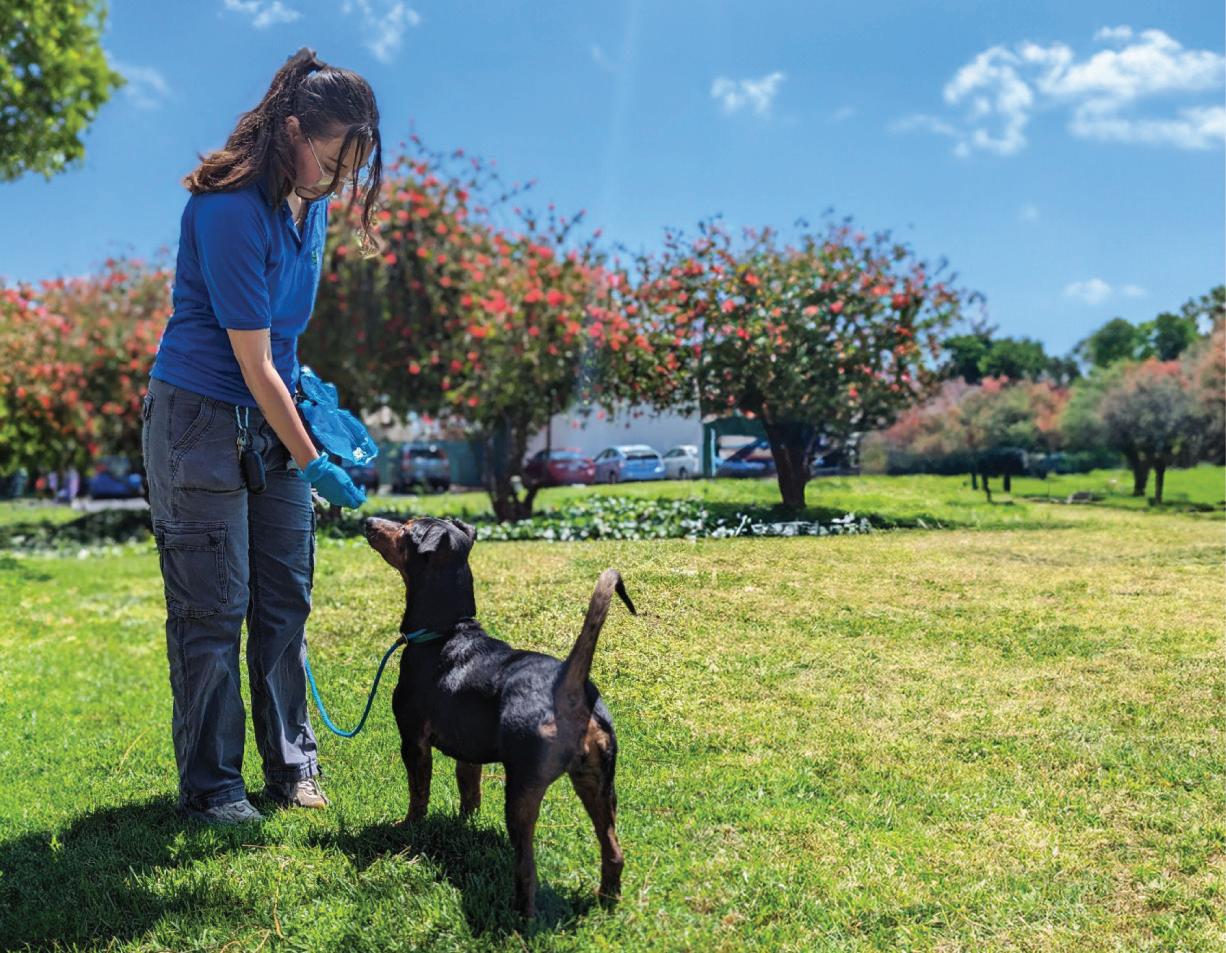


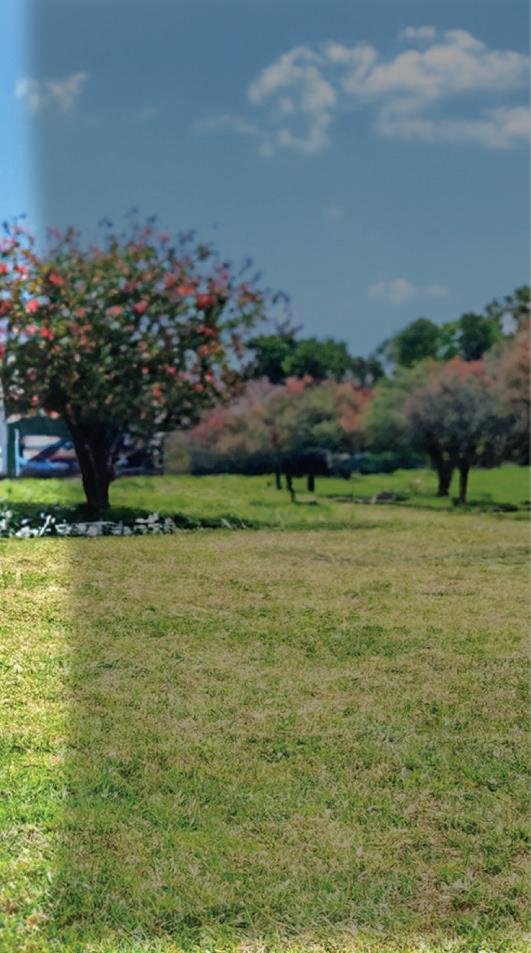






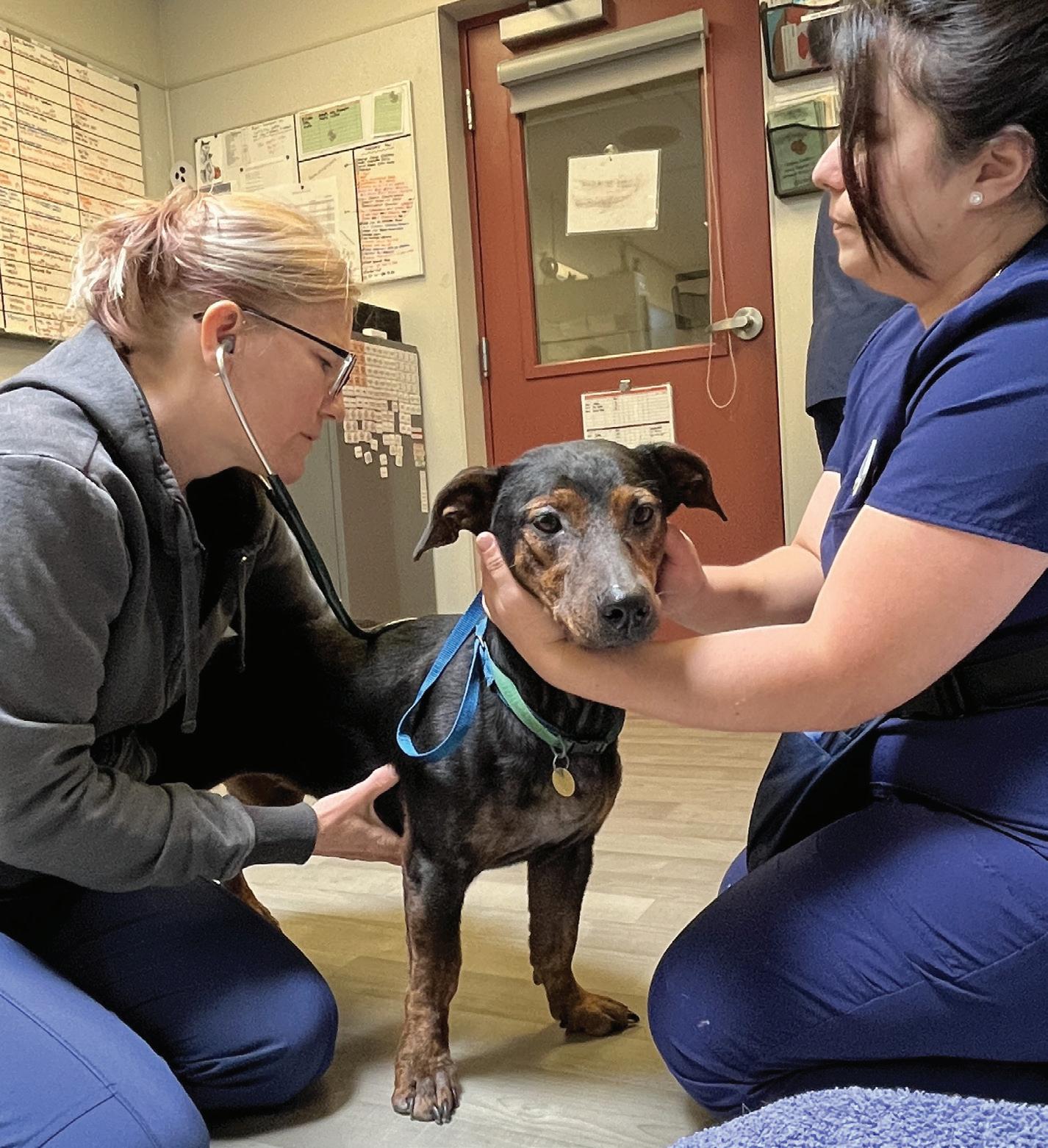
breeds are also recommended for spaying (female castration) only after two years of age: Boxers, Cocker Spaniels, Doberman Pinschers, German Shepherds, Shetland Sheepdogs and Shih Tzus.
Thankfully, East Bay dog owners don’t have to worry about jumping through more hoops if they choose to start following these new guidelines. Boarding house Happy Hound will still dogsit and/ or train unfixed pets, and they are still welcome at East Bay SPCA’s training classes. What’s most important is a dog’s comfort, and the trainers put their trust in owners to determine that.
“We always tell owners to advocate for their animals,” said Kate Witzke, the East Bay SPCA’s behavior and training manager. The training depends on the personality and genetic history of the dog, which is why owners are the best advocates for their pets.
The effect of fixing is also dependent on the dog. Witzke said that solving
hormonal-attributed behavioral problems with fixing “varies widely [and] greatly depends on the behavior you’re looking at.” Behavioral modification training is still typically necessary to reduce and lose the behavior.
Kristen Beitzel, the vice president of medical services at East Bay SPCA, said approximately a fifth of clients coming through the clinic are interested in leaving their pets intact.
“We provide education around the pros and cons of fixing without passing judgment,” said Beitzel. “We let them make their own decisions. If they want to breed their animal, we will go into the responsibilities of breeding: the testing you should be doing, the raising. Here we will help people go down the responsible breeding path rather than backyard breeding [one].”
If owners aren’t interested in breeding but still don’t want to fix their pets, they
GOOD DOGS According to the East Bay SPCA, spaying or neutering can have mixed effects on behavior.
still have a place at Beitzel’s clinic and Witzke’s training program.
Kristy Lai, a manager at Happy Hound—a daycare, boarding and training facility in Oakland—has a process for how intact new dogs are incorporated into the programs. “We try them out in playgroup, and if it’s safe and they don’t have any behavioral issues, such as excessive humping or following a certain dog, [which] create issues for safety, then they’re fine and welcome to be in playgroup,” Lai explained.
If there is a problem behavior, the trainers won’t give up. “We give them a few chances, we give them a timeout to see if the behavior corrects itself,” said Lai. “If we find it doesn’t, then we have that conversation with the parents.”
Even then, the dog isn’t left out on the street; Happy Hound has an enhanced care program that is specifically designed for dogs unable to join the other pups. Lai approximates that 75% of males have gone into the enhanced care program, where dogs are given their own room and are taken out every two hours. Females are typically okay in playgroup, unless they are in heat, in which case they also get their own rooms—owners are told to bring their dog’s period diapers.
Cats haven’t been found to have any similar effects from neutering. Since the statewide concern for cats is population overgrowth, early neutering is to avoid even that first kitten season for a newly matured cat. Dogs are more sensitive to reproductive procedures.
For more resources on reproductive surgeries, associated behavioral problems and solutions, East Bay SPCA provides free tips and guidelines on their website: eastbayspca.org.





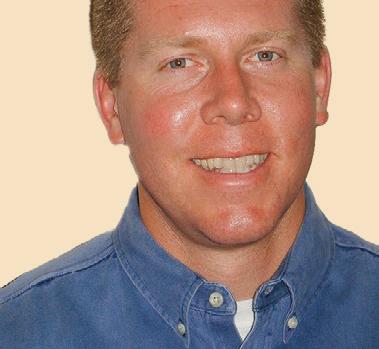


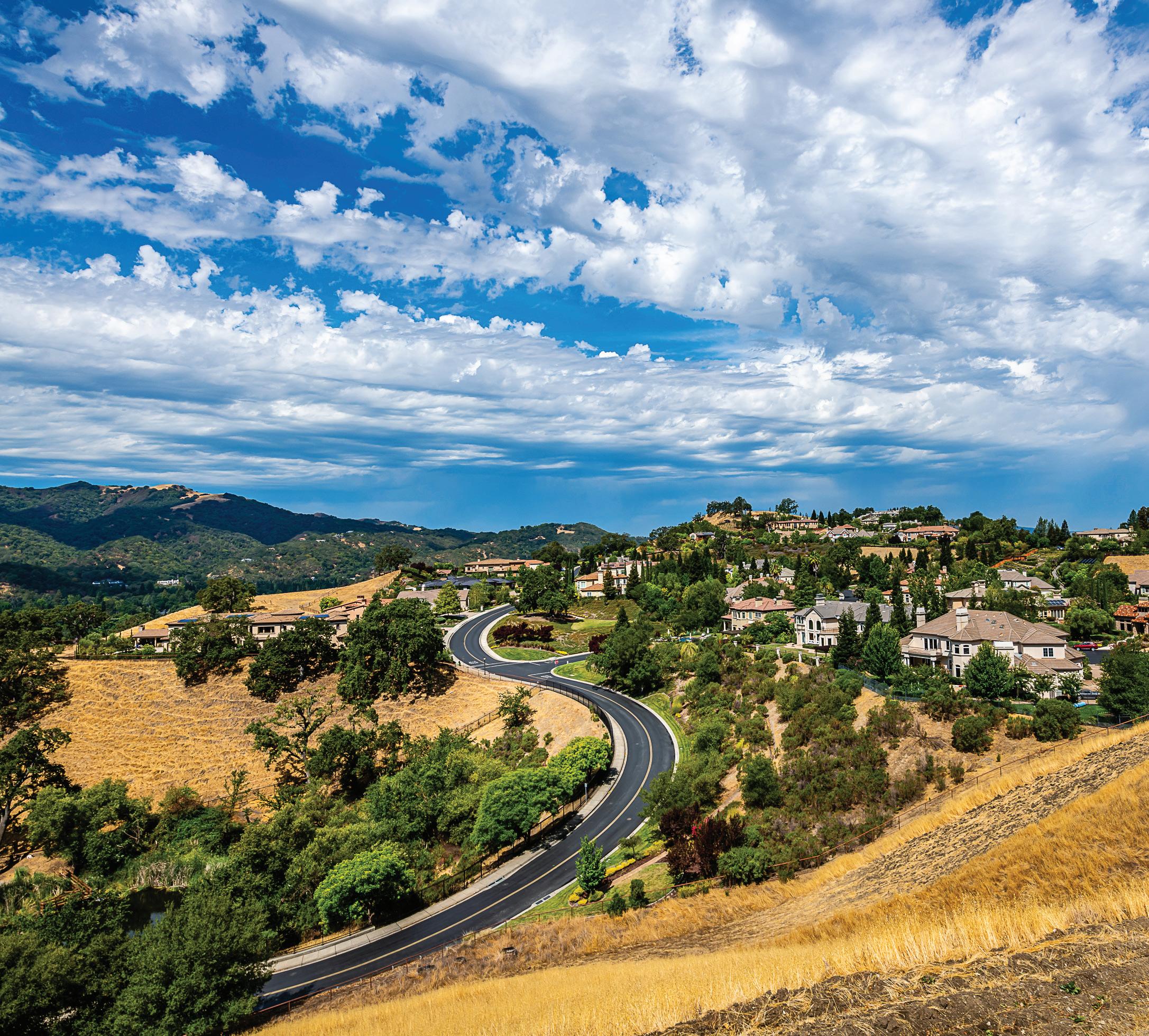
BY Panashe Matemba-Mutasa


State Farm slowly backing out on customers as California fire risk rises
On the afternoon of Oct, 19, 1991, Beth Keer hiked up Sonoma Mountain with a friend. After some time, the pair looked back and spotted a plume of smoke in Oakland’s direction. Frantic, they rushed down the mountain, and Keer’s friend, who lived in Oakland at the time, prepared for a potential evacuation. Fortunately, neither of their homes was demolished, but the two witnessed the aftermath of what was one of the most devastating wildfires in the Bay Area’s history.
“I said, ‘uh oh,’” Keer recalled. “It was pretty scary.”
Destroying 3,400 homes, the Oakland firestorm of 1991 is a harrowing memory for anyone who is old enough to recall it. Images of blowing ash and trees exploding on television still haunt survivors. What’s worse, the prevalence of fires like these is increasing by the year. According to Cal Fire, just over 4 million acres were scorched across the state in 2020, the most in history. With climate change, these numbers are projected to climb.
But the loss doesn’t stop at decimated communities. In response to the increased fire risk, insurance companies are abandoning their customers.
On March 20, California’s largest home insurer, State Farm, announced they would be making the decision to nonrenew approximately 30,000 homeowner and rental policies in the state. With the expiry date on their coverage fast approaching, many State Farm policyholders are turning to the CA FAIR Plan: a private insurer that some consider a “last resort” due to a hefty cost.
“This decision was not made lightly and only after careful analysis of State Farm
General’s financial health, which continues to be impacted by inflation, catastrophe exposure, reinsurance costs and the limitations of working within decadesold insurance regulations,” said Sevag Sarkissian, State Farm media specialist.
Insurance cancellations will take place on a rolling basis beginning on July 3, 2024, for homeowners, renters, business owners and residential community associations, and on Aug. 20 for commercial apartment policies.
This news comes as California has seen a number of record-breaking heat waves recently. The US Environmental Protection Act reports that climate change is hitting the already dry state hard: The days are getting hotter, snow is melting earlier and rainfall is decreasing. As of May 2024, the California Department of Forestry and Fire Protection recorded over 1,500 fires since the beginning of this year.
An interactive map depicts ZIP codes where policies will not be renewed, with the biggest share being 94563 in Contra Costa County that includes Orinda, Lafayette and Eastport. However, Bay Area residents outside of the listed ZIP codes still face looming insurance cancellations.
State Farm’s non-renewals are sending shock waves through a community in the Oakland Hills, the eastern part of the city that was devastated by the infamous fire of 1991. Keer, who moved to the area in 1995, recently discovered that her coverage is on the chopping block.
Like many residents, Keer was drawn to the hills’ idyllic parks and tranquility. But these perks came at a price. Due to invasive and highly flammable vegetation and debris, the state considers the hills as highly fire-prone.

“It’s a shame, we have these beautiful parks, but they’re high fire risk,” Keer said.
The fire threat in the Oakland Hills is much like any forested area, with dead trees and fallen branches being key risk culprits. But the situation in the hills is unique due to an abnormal abundance of non-native acacia and eucalyptus trees, the latter of which have oils in their leaves that make them particularly flammable. Keer frequents Joaquin Miller Park, one of the parks in the hills known for its breathtaking wooded trails. But she’s disappointed every time she goes and is reminded of the city’s negligence of the area.
“Our regional parks are dangerously overgrown and poorly maintained,” Keer said.
But the standards for residents in the area are much higher, especially if they want to remain insured. Before switching to State Farm, Keer was insured through USAA. Every year, USAA has conducted compliance inspections for homeowners, including guidelines to remove dead shrubs and leaves, clearing the roof and gutters, and keeping grass and weeds mowed.
Keer said she had been diligent about adhering to the guidelines, but that hasn’t always meant she’s in the “clear.” During one visit, Keer said an inspector canceled her insurance over “a little shrub,” marking only the beginning of her battle with fire insurance companies.
“I protested that so hard,” Keer said. “Eventually, I gave up and switched to State Farm.”
She had State Farm for the last 15 years and has now switched to the CA Fair Plan after being hit by the cancellation rollout. The plan markets itself as a “safety net,” providing coverage when other insurers step back. It acts as temporary insurance while residents seek a traditional, permanent plan.
Unfortunately, this backup option is costing homeowners like Keer up to double what they were paying previously. She currently pays $5350 per year for just fire insurance with the FAIR Plan, whereas before, with State Farm, she paid $3800, and that included all other types of homeowner’s insurance.
Some have taken to organizing to

preserve and get their insurance back. Dawn Wheeler, a resident of the Piedmont Pines neighborhood in the Oakland Hills, is a member of the Piedmont Pines Neighborhood Association (PPNA), a neighborhood-wide volunteer group established in 1941 that works to keep the area fireproof by hosting fire-related seminars, town hall meetings and other educational events.
It’s an approach that’s been taken in Moraga, another high-altitude area with fire-prone neighborhoods. But even as they collectively try to educate each other on compliance standards, insurance companies update their policies often, so it’s difficult for even the most seasoned home hardeners to stay ahead of the curve.
“I think the goalpost absolutely moves,” Wheeler said.
As State Farm shows no signs of reversing these policy changes, the state of fire insurance in the Oakland Hills looks bleak. Like Keer, Wheeler is reluctantly looking into the pricey FAIR Plan as a last resort option. But as more Californians are turning to it, the system becomes more overwhelmed—a trend that could hurt
the financial future of the FAIR Plan, says president Victoria Roach.
With primary and backup forms of fire insurance at risk, the people of the Oakland Hills can only look to their community for answers. District 4 council member Janani Ramachandran said her main focus is to work with the state to secure funding for a more robust Oakland Fire Department (OFD).
Currently, the department has 500 sworn personnel but has had to freeze some positions due to budget constraints. Ramachandran’s goal is to collaborate with OFD and secure funding to unfreeze the fire inspector and deputy captain roles.
“We’re hoping to collectively apply pressure,” Ramachandran said.
OFD Fire Marshal Felicia Bryant reiterated the importance of home hardening at a PPNA town hall meeting recently. She urged the neighborhood to stay up-to-date on protocols, reminding them that a repeat of 1991 is very feasible, and this time, insurance doesn’t have their backs.
“A fire can happen at any point,” Bryant said. “Make sure your home is ready.” ❤
Garbage is a manufactured product, created when otherwise recoverable resources are mixed and mashed together. Most rooms in every building in the whole country have a basket where this manufacturing begins. Discarded resources are put in one by one, then dumped into a larger bin, and then into a truck with a more modern body based on this one. A hydraulic piston smashes everything together. The objective is to pack in more cargo before the truck has to be driven to where it can dump onto the land, to be covered in a “sanitary“ way. Liquids leach out and make their way into the planet's

water eventually. These “sanitary” methods of filling the land (hence “sanitary landfills”) also provide for anaerobic decomposition of organic materials – which makes methane.
Landfills are the largest human-created source of methane. In the short term methane is 80-100 times
more powerful than carbon dioxide to warm the planet.
If you're not for Zero Waste, how much waste are you for?
NASA's Astronomy Picture of the Day from February 12, 2002, colored the methane in the Earth's atmosphere green, and an animation showed how it spins to the poles NASA said, “Methane (CH4) is second only to carbon dioxide (CO2) in creating a warming greenhouse effect The largest abundance released by the US … is created when anaerobic bacteria break down carbon-based garbage in landfills.” [Emphasis added ]

Urban Ore has been salvaging for reuse in Berkeley since 1981. We have 3 acres of secondhand goods, open 360 days a year until 5:00PM, 900 Murray St. near 7th x Ashby. Come shop.





